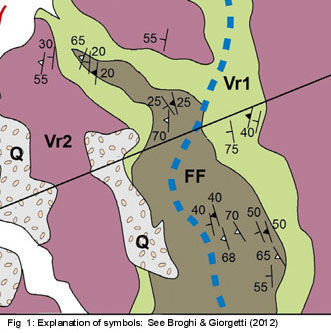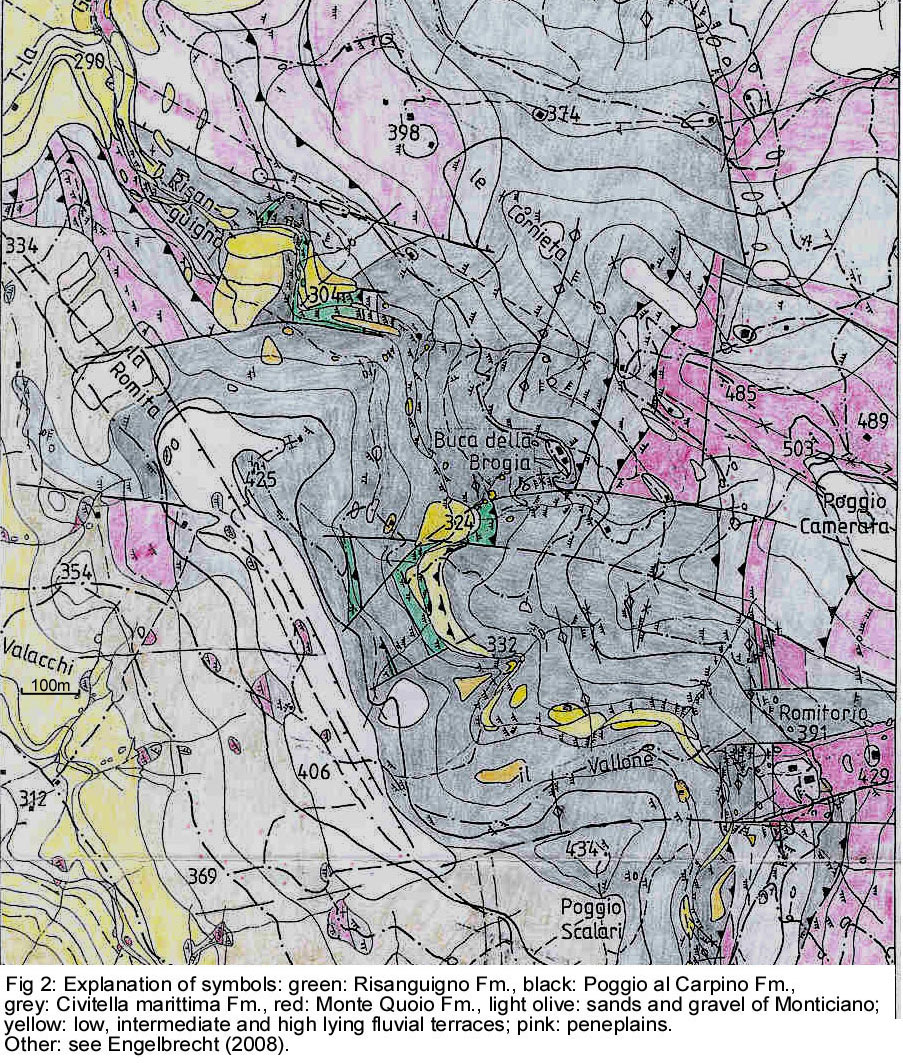Discussion of the
paper
Brogi, Andrea & Giorgetti, Giovanna
(2012): Tectono-metamorphic evolution of the
siliciclastic units in the Middle Tuscan Range (inner
Northern Apennines): Mg-carpholite bearing quartz veins
related to syn-metamorphic syn-orogenic foliation.-
Tectonophysics 526-529: 167-184, Elsevier, Amsterdam.
I thank for the information published in
Tectonophysics 526-529: 167-184 (2012) about the geology
of the Monticiano-Roccastrada Range, the new findings
there of Mg-Carpholite and a more precise documentation
and reconstruction of the HP-LT metamorphic evolution of
that area characterized by middle-late Tertiary
subduction-related tectonic burial and exhumation. This
is important work.
In advance to the following lines, I want to declare one
general point of academic interest and importance: an
intellectual model can't be better than the quality of
the facts on which it stands on or from which it is
derived of. This means in the case here: a reliable,
high-quality model of the tectono-metamorphic evolution
of the Monticiano-Roccastrada Area can only be setup, if
the basics, which can here only be thorough mapping work,
has as carefully and accurately as possible been
accomplished. I am well aware that the realization of
this compellingly high demand means hardest work.
The reason for discussing the paper is as follows: some
years ago, I mapped an area of ca. 7 km² between
Ferriera (P 263m) in the Farma Valley and the village
Monticiano at scale 1:10.000. During that private
post-doc-activity on my own account and my own costs, I
studied and analyzed the geological relations between the
Risanguigno Formation present at the type locality Rio
Risanguigno close to Monticiano and lithologic
equivalents of that Formation present at Ferriera (P
263m) in the Farma Valley ca. 5,3 km to the south. It was
- as I already experienced in the Farma Valley - a
time-consuming and exhausting step by step mapping work,
where the detectability and interpretation of geological
boundaries is hampered and complicated, because nearly
all of them are covered beneath late Quaternary detritus.
A visual comparison revealed that the northern part of my
map - not yet published - is geographically identic with
a part in the western section of the map of Broghi &
Giorgetti (2012) in Fig. 5 on page 172 of their paper. So
it is possible to compare and to comment the geological
results. This common area contains geographically the
northern part of Rio Risanguigno Valley, Poggio Camerata,
Romitorio, Poggio Scalari 434m, Fosso Rifregaio and a
small part of the Torrente la Gonna Valley. The
complexity-grade of the geomorphologic pattern of the
common map-part is rather high; this indicates a
difficult geological situation and the information found
needs sensible geological interpretation.
First of all, I refer to the common map-part. The
geological mapping results - these of Broghi &
Giorgetti is Figure 1 and my one is Figure 2 - differ
essentially. This may be partly explained, if it is the
case that Broghi & Giorgetti and Engelbrecht worked
at different map-scales.
Figure 1
(Broghi & Giorgetti)

|
Figure 2
(Engelbrecht)

|
The lithostratigraphy in Figure 1
consists of the Poggio al Carpino Formation (Late Permian
- early Triassic) (part of the Phyllite-Quartzite-Group)
at the base, which is overlain by the Verrucano Group,
composed of the Civitella Marittima Formation (Induan -
Anisian) and the Monte Quoio Formation (Anisian -
Ladinian). In the chapter Stratigraphy (p.170) of Broghi
& Giorgetti (2012) no single word is written about
the type locality of the Risanguigno Formation - which
occurs in the northern part of the Risanguigno Valley
present in Figure 1 - and about the problematic age
attributions of the Poggio al Carpino Formation, the
Civitella Marittima Formation and the Verrucano Group;
see my detailed discussion on the site http://www.umweltgeol-he.de/discussion1.htm
.
In Figure 1, the general tectonic situation consists
essentially of two superimposed Tertiary folding events:
the first event DE1 produced an isoclinal antiform with
the Poggio al Carpino Formation in the fold-core, which
was refolded by a second event DE2. The fold axes entered
in Figure 1 persist on km-scale. The sequence plotted
east of the isoclinal DE2-antiform is tectonically
overturned on km-scale; but the tectonic overturning is
not supported by data in Figure 1: they are missing or
lack ascertained sedimentary polarity. The tectonic
concept presented in Figure 1 is in logical conflict with
the citations in the chapter Geological Outlines on page
169-170 in the paper of Broghi & Giorgetti (2012),
where the facts of "superimposed generations of
normal faults" and "internal thrusting, which
affected the Verrucano Group and the Phyllite-Quartzite
Group" are cited, which of course also occur in the
area under consideration. So it is astonishing that no
tectonic thrust and only one single normal fault is
present in Figure 1. In addition: neither the tectonic
concept nor the heterogenous lithologies of the
Formations can account for the geomorphological
complexity-grade of the area.
In my Figure 2, the lithostratigraphic base comprises -
of course - the Risanguigno Formation, present in six
scattered outcrops at the type locality - defined and
published by Bagnoli & Tongiorgi (1979) - in the
northern part of the Risanguigno Valley. According to my
idea, this Formation is thrusted either onto the Poggio
al Carpino Formation or onto the Civitella Marittima
Formation. The area is intersected by normal faults and
wrench faults into numerous tectonic blocks, in which the
folded and/or thrusted sequence consisting of Poggio al
Carpino Formation, Civitella marittima Formation and
Monte Quoio Formation appears in stratigraphic order; the
area seems to be megabrecciated as in the Farma Valley.
The constructed b-axes are persistent on max. 350m.
Isoclinal folds were found rarely in outcrop; but when
present, they even occur in very competent lithologies
like thick layered quartzconglomerates of the Monte Quoio
Formation; isoclinal refolding of isoclinal folds was not
observed. In the eastern part of Figure 2, large-scale
tectonic overturning could not be ascertained. Some of
the strike directions of the faults plotted in Figure 2
correlate with main directions present in the recent
geomorphological pattern.
Geological misinterpretations in my Figure 2 were - of
course - unavoidable and must be present due to 1)
overcharge by complexity, 2) precarious outcrop situation
and geographical orientation and 3) personal errors (our
all fate is "errare humanum est"). If there is
enough time in my life, I will control my mapping work
again to improve it.
Now it is the reader's turn to decide which of the
Figures 1 or 2 is more reliable and seems more realistic.
In addition to my self-critics and critics on the
stratigraphy, tectonics and mapping work of Broghi &
Giorgetti (2012), I do not agree with the general
tectonometamorphic subdivision of the
Monticiano-Roccastrada Range and the Monte Leoni Area, as
given in the Fig. 4b on page 171 of Broghi &
Giorgetti (2012). The reader can find my arguments in the
second paragraph of the discussion on the site http://www.umweltgeol-he.de/discussion2.htm
and in Engelbrecht 1997: 527 (Zeitschrift
der Deutschen Geologischen Gesellschaft 148/3-4: 523-546).
Concerning the schematic lithostratigraphic column in
Fig. 6 on page 173 of the paper of Broghi & Giorgetti
(2012): the grade of simplification is unacceptably
high and the plotted arrangements and interrelations of
sedimentary textures and structures are often wrong.
Although laid down under differing depositional
conditions, the Civitella marittima Formation and the
lower part of the Monte Quoio Formation were supplied in
their graphical representations in Fig. 6 with nearly
identic patterns of lines reflecting the stratification.
It is astonishing that the abbreviation FF means Poggio
al Carpino Formation (and not Farma Formation) and that
the sedimentology entered in that Formation consists
merely of the symbols for pelites and siltstones. The
graphic presentation of the Anageniti minute Formation in
Fig. 6 as massive, fining upward cycle can't be accepted.
The abbreviations CCA and RET are not explained.
It is confusing that in Fig. 12 on page 178 of the paper
of Broghi & Giorgetti (2012) some
mineral-abbreviations in the figure-caption are not
identic with the abbreviations for the mineral phases in
the corresponding P-T-diagram immediately above
(kln-Kaol, prl-Pyr, qtz-Qz, cld-Ctd) and that in this
figure-caption the Alumosilicate Kyanite Al2SiO5 is
mistaken with the Potassium-Magnesium-Hydrosulfate
Kainite KMg(Cl/SO4)2,75H2O. In the figure-caption, two
abbreviations (prl-pyr) were used for one and the same
mineral phase Pyrophyllite.
Some years ago, I corresponded with Bruno Goffé - a
referee of Broghi & Giorgetti's paper (2012) - to
exchange ideas about the geologic and metamorphic history
of the Monticiano-Roccastrada Range and I sent him my
doctoral thesis containing map and profiles of the Farma
Valley. It is astonishing that he did not make any use of
all that information, when he evaluated the paper of
Broghi & Giorgetti (2012).
In sum: according to my opinion, the
mineralogical-petrogenetical information of the paper of
Broghi & Giorgetti (2012) is ok, but not the
geological one concerning mapping work, tectonic model,
profiles, lithostratigraphy and age attribution of the
geological Formations. It seems strange to me that Broghi
& Giorgetti and the referees of their paper ignored
my published geological work, the references of which are
online. I recommend academic decartellization,
democratization of citation-politics as well as
appreciation and involvement of other qualitatively
established opinions. Otherwise academic autism as well
as academic endogamy will prevent exchange of new and
good ideas and block scientific progress.
It is disappointing that such partially low quality
paper was published in a high quality journal, the
contributions of which I read since 1980. I think that
the journal Tectonophysics needs - at least in some cases
- a better quality control concerning the papers of
authors, which submit there.
|

